Evaluation of Coca-Cola’s Marketing Mix
VerifiedAdded on 2023/04/22
|11
|2345
|451
AI Summary
This report evaluates Coca-Cola's marketing strategies and the way it has been increasing its growth to acquire competitive gains in the Food and Beverages (F&B) sector of Australia. The report has conducted a marketing mix on Coca-Cola’s business strategies to enable the firm in understanding the dynamics and tactics involved between the four core elements namely product, place, price and promotion.
Contribute Materials
Your contribution can guide someone’s learning journey. Share your
documents today.
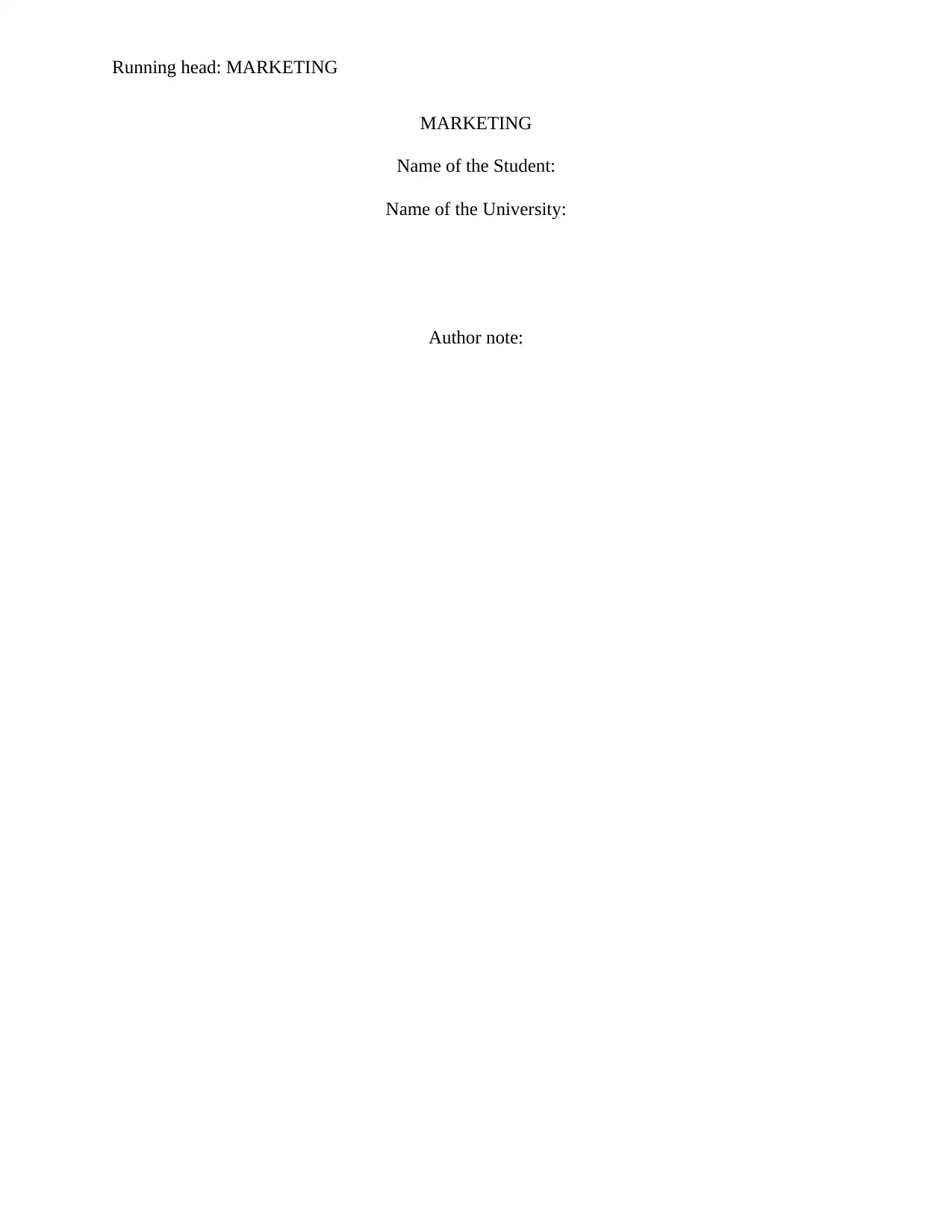
Running head: MARKETING
MARKETING
Name of the Student:
Name of the University:
Author note:
MARKETING
Name of the Student:
Name of the University:
Author note:
Secure Best Marks with AI Grader
Need help grading? Try our AI Grader for instant feedback on your assignments.
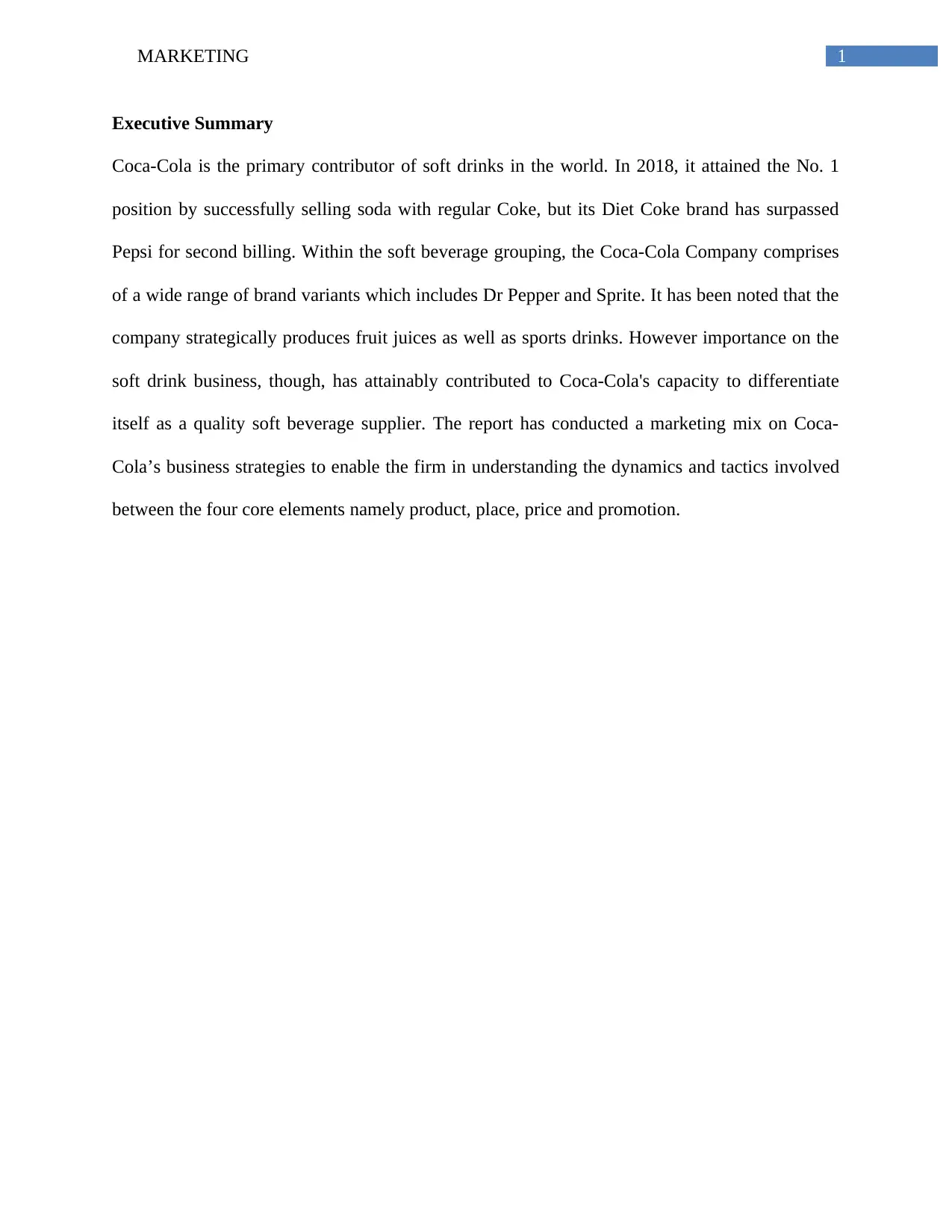
1MARKETING
Executive Summary
Coca-Cola is the primary contributor of soft drinks in the world. In 2018, it attained the No. 1
position by successfully selling soda with regular Coke, but its Diet Coke brand has surpassed
Pepsi for second billing. Within the soft beverage grouping, the Coca-Cola Company comprises
of a wide range of brand variants which includes Dr Pepper and Sprite. It has been noted that the
company strategically produces fruit juices as well as sports drinks. However importance on the
soft drink business, though, has attainably contributed to Coca-Cola's capacity to differentiate
itself as a quality soft beverage supplier. The report has conducted a marketing mix on Coca-
Cola’s business strategies to enable the firm in understanding the dynamics and tactics involved
between the four core elements namely product, place, price and promotion.
Executive Summary
Coca-Cola is the primary contributor of soft drinks in the world. In 2018, it attained the No. 1
position by successfully selling soda with regular Coke, but its Diet Coke brand has surpassed
Pepsi for second billing. Within the soft beverage grouping, the Coca-Cola Company comprises
of a wide range of brand variants which includes Dr Pepper and Sprite. It has been noted that the
company strategically produces fruit juices as well as sports drinks. However importance on the
soft drink business, though, has attainably contributed to Coca-Cola's capacity to differentiate
itself as a quality soft beverage supplier. The report has conducted a marketing mix on Coca-
Cola’s business strategies to enable the firm in understanding the dynamics and tactics involved
between the four core elements namely product, place, price and promotion.
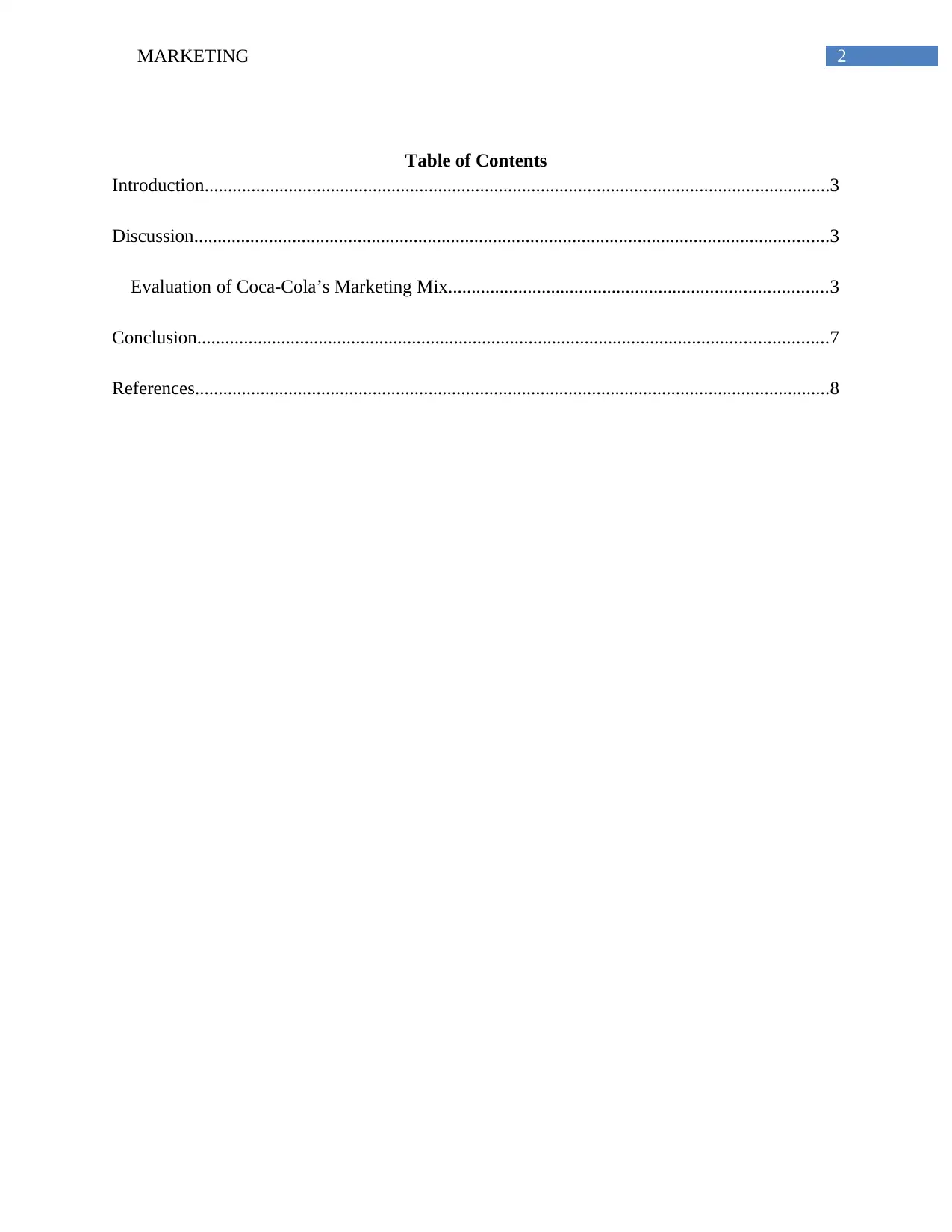
2MARKETING
Table of Contents
Introduction......................................................................................................................................3
Discussion........................................................................................................................................3
Evaluation of Coca-Cola’s Marketing Mix.................................................................................3
Conclusion.......................................................................................................................................7
References........................................................................................................................................8
Table of Contents
Introduction......................................................................................................................................3
Discussion........................................................................................................................................3
Evaluation of Coca-Cola’s Marketing Mix.................................................................................3
Conclusion.......................................................................................................................................7
References........................................................................................................................................8
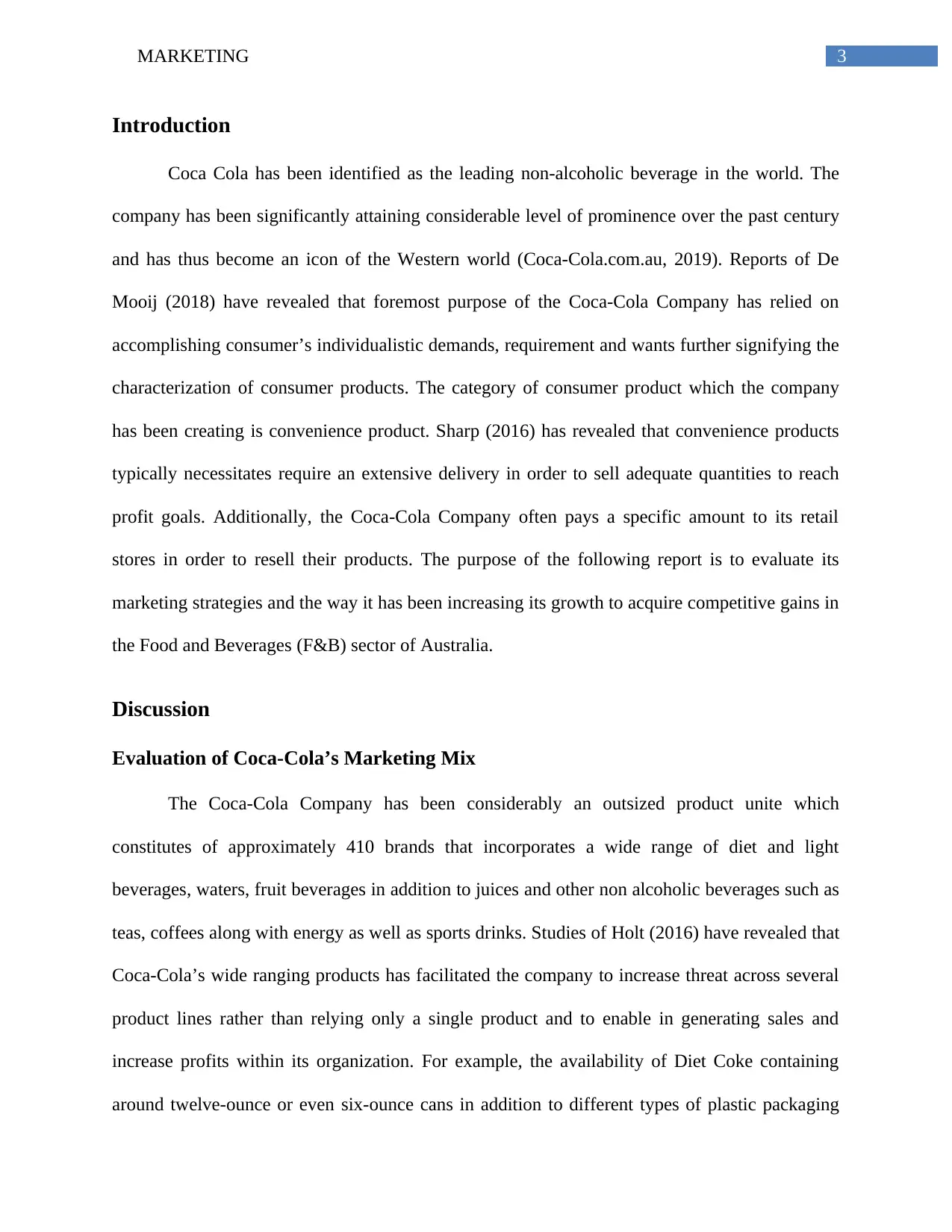
3MARKETING
Introduction
Coca Cola has been identified as the leading non-alcoholic beverage in the world. The
company has been significantly attaining considerable level of prominence over the past century
and has thus become an icon of the Western world (Coca-Cola.com.au, 2019). Reports of De
Mooij (2018) have revealed that foremost purpose of the Coca-Cola Company has relied on
accomplishing consumer’s individualistic demands, requirement and wants further signifying the
characterization of consumer products. The category of consumer product which the company
has been creating is convenience product. Sharp (2016) has revealed that convenience products
typically necessitates require an extensive delivery in order to sell adequate quantities to reach
profit goals. Additionally, the Coca-Cola Company often pays a specific amount to its retail
stores in order to resell their products. The purpose of the following report is to evaluate its
marketing strategies and the way it has been increasing its growth to acquire competitive gains in
the Food and Beverages (F&B) sector of Australia.
Discussion
Evaluation of Coca-Cola’s Marketing Mix
The Coca-Cola Company has been considerably an outsized product unite which
constitutes of approximately 410 brands that incorporates a wide range of diet and light
beverages, waters, fruit beverages in addition to juices and other non alcoholic beverages such as
teas, coffees along with energy as well as sports drinks. Studies of Holt (2016) have revealed that
Coca-Cola’s wide ranging products has facilitated the company to increase threat across several
product lines rather than relying only a single product and to enable in generating sales and
increase profits within its organization. For example, the availability of Diet Coke containing
around twelve-ounce or even six-ounce cans in addition to different types of plastic packaging
Introduction
Coca Cola has been identified as the leading non-alcoholic beverage in the world. The
company has been significantly attaining considerable level of prominence over the past century
and has thus become an icon of the Western world (Coca-Cola.com.au, 2019). Reports of De
Mooij (2018) have revealed that foremost purpose of the Coca-Cola Company has relied on
accomplishing consumer’s individualistic demands, requirement and wants further signifying the
characterization of consumer products. The category of consumer product which the company
has been creating is convenience product. Sharp (2016) has revealed that convenience products
typically necessitates require an extensive delivery in order to sell adequate quantities to reach
profit goals. Additionally, the Coca-Cola Company often pays a specific amount to its retail
stores in order to resell their products. The purpose of the following report is to evaluate its
marketing strategies and the way it has been increasing its growth to acquire competitive gains in
the Food and Beverages (F&B) sector of Australia.
Discussion
Evaluation of Coca-Cola’s Marketing Mix
The Coca-Cola Company has been considerably an outsized product unite which
constitutes of approximately 410 brands that incorporates a wide range of diet and light
beverages, waters, fruit beverages in addition to juices and other non alcoholic beverages such as
teas, coffees along with energy as well as sports drinks. Studies of Holt (2016) have revealed that
Coca-Cola’s wide ranging products has facilitated the company to increase threat across several
product lines rather than relying only a single product and to enable in generating sales and
increase profits within its organization. For example, the availability of Diet Coke containing
around twelve-ounce or even six-ounce cans in addition to different types of plastic packaging
Secure Best Marks with AI Grader
Need help grading? Try our AI Grader for instant feedback on your assignments.
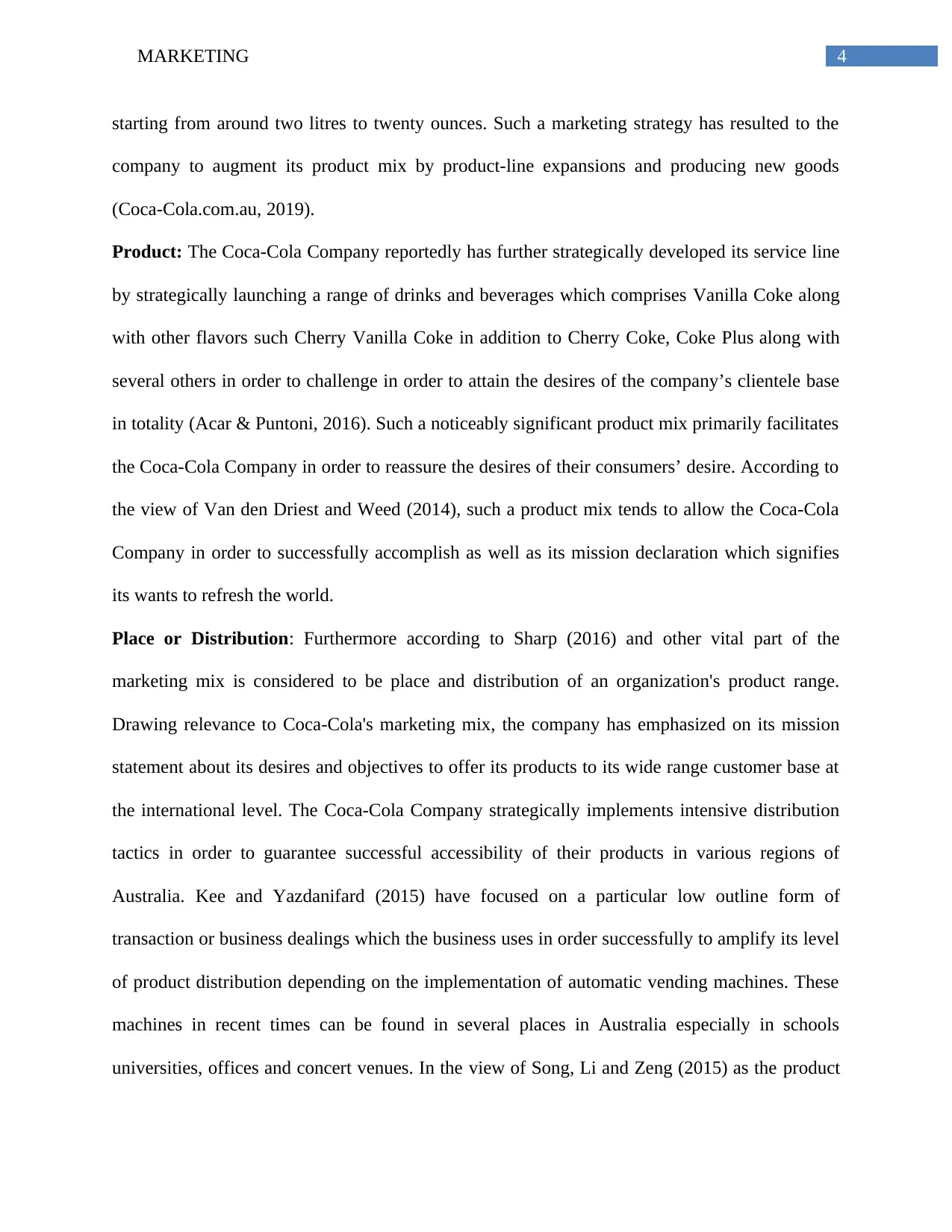
4MARKETING
starting from around two litres to twenty ounces. Such a marketing strategy has resulted to the
company to augment its product mix by product-line expansions and producing new goods
(Coca-Cola.com.au, 2019).
Product: The Coca-Cola Company reportedly has further strategically developed its service line
by strategically launching a range of drinks and beverages which comprises Vanilla Coke along
with other flavors such Cherry Vanilla Coke in addition to Cherry Coke, Coke Plus along with
several others in order to challenge in order to attain the desires of the company’s clientele base
in totality (Acar & Puntoni, 2016). Such a noticeably significant product mix primarily facilitates
the Coca-Cola Company in order to reassure the desires of their consumers’ desire. According to
the view of Van den Driest and Weed (2014), such a product mix tends to allow the Coca-Cola
Company in order to successfully accomplish as well as its mission declaration which signifies
its wants to refresh the world.
Place or Distribution: Furthermore according to Sharp (2016) and other vital part of the
marketing mix is considered to be place and distribution of an organization's product range.
Drawing relevance to Coca-Cola's marketing mix, the company has emphasized on its mission
statement about its desires and objectives to offer its products to its wide range customer base at
the international level. The Coca-Cola Company strategically implements intensive distribution
tactics in order to guarantee successful accessibility of their products in various regions of
Australia. Kee and Yazdanifard (2015) have focused on a particular low outline form of
transaction or business dealings which the business uses in order successfully to amplify its level
of product distribution depending on the implementation of automatic vending machines. These
machines in recent times can be found in several places in Australia especially in schools
universities, offices and concert venues. In the view of Song, Li and Zeng (2015) as the product
starting from around two litres to twenty ounces. Such a marketing strategy has resulted to the
company to augment its product mix by product-line expansions and producing new goods
(Coca-Cola.com.au, 2019).
Product: The Coca-Cola Company reportedly has further strategically developed its service line
by strategically launching a range of drinks and beverages which comprises Vanilla Coke along
with other flavors such Cherry Vanilla Coke in addition to Cherry Coke, Coke Plus along with
several others in order to challenge in order to attain the desires of the company’s clientele base
in totality (Acar & Puntoni, 2016). Such a noticeably significant product mix primarily facilitates
the Coca-Cola Company in order to reassure the desires of their consumers’ desire. According to
the view of Van den Driest and Weed (2014), such a product mix tends to allow the Coca-Cola
Company in order to successfully accomplish as well as its mission declaration which signifies
its wants to refresh the world.
Place or Distribution: Furthermore according to Sharp (2016) and other vital part of the
marketing mix is considered to be place and distribution of an organization's product range.
Drawing relevance to Coca-Cola's marketing mix, the company has emphasized on its mission
statement about its desires and objectives to offer its products to its wide range customer base at
the international level. The Coca-Cola Company strategically implements intensive distribution
tactics in order to guarantee successful accessibility of their products in various regions of
Australia. Kee and Yazdanifard (2015) have focused on a particular low outline form of
transaction or business dealings which the business uses in order successfully to amplify its level
of product distribution depending on the implementation of automatic vending machines. These
machines in recent times can be found in several places in Australia especially in schools
universities, offices and concert venues. In the view of Song, Li and Zeng (2015) as the product
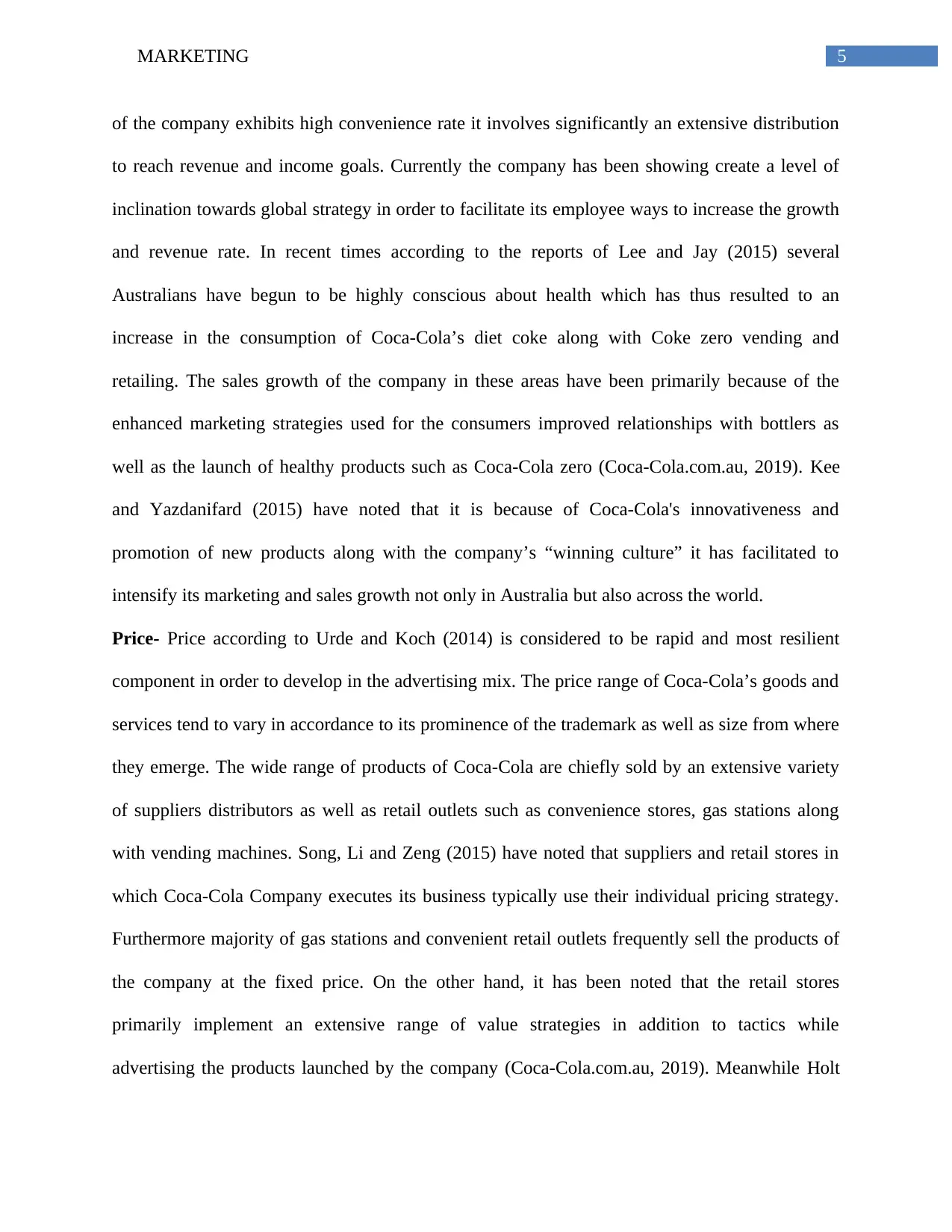
5MARKETING
of the company exhibits high convenience rate it involves significantly an extensive distribution
to reach revenue and income goals. Currently the company has been showing create a level of
inclination towards global strategy in order to facilitate its employee ways to increase the growth
and revenue rate. In recent times according to the reports of Lee and Jay (2015) several
Australians have begun to be highly conscious about health which has thus resulted to an
increase in the consumption of Coca-Cola’s diet coke along with Coke zero vending and
retailing. The sales growth of the company in these areas have been primarily because of the
enhanced marketing strategies used for the consumers improved relationships with bottlers as
well as the launch of healthy products such as Coca-Cola zero (Coca-Cola.com.au, 2019). Kee
and Yazdanifard (2015) have noted that it is because of Coca-Cola's innovativeness and
promotion of new products along with the company’s “winning culture” it has facilitated to
intensify its marketing and sales growth not only in Australia but also across the world.
Price- Price according to Urde and Koch (2014) is considered to be rapid and most resilient
component in order to develop in the advertising mix. The price range of Coca-Cola’s goods and
services tend to vary in accordance to its prominence of the trademark as well as size from where
they emerge. The wide range of products of Coca-Cola are chiefly sold by an extensive variety
of suppliers distributors as well as retail outlets such as convenience stores, gas stations along
with vending machines. Song, Li and Zeng (2015) have noted that suppliers and retail stores in
which Coca-Cola Company executes its business typically use their individual pricing strategy.
Furthermore majority of gas stations and convenient retail outlets frequently sell the products of
the company at the fixed price. On the other hand, it has been noted that the retail stores
primarily implement an extensive range of value strategies in addition to tactics while
advertising the products launched by the company (Coca-Cola.com.au, 2019). Meanwhile Holt
of the company exhibits high convenience rate it involves significantly an extensive distribution
to reach revenue and income goals. Currently the company has been showing create a level of
inclination towards global strategy in order to facilitate its employee ways to increase the growth
and revenue rate. In recent times according to the reports of Lee and Jay (2015) several
Australians have begun to be highly conscious about health which has thus resulted to an
increase in the consumption of Coca-Cola’s diet coke along with Coke zero vending and
retailing. The sales growth of the company in these areas have been primarily because of the
enhanced marketing strategies used for the consumers improved relationships with bottlers as
well as the launch of healthy products such as Coca-Cola zero (Coca-Cola.com.au, 2019). Kee
and Yazdanifard (2015) have noted that it is because of Coca-Cola's innovativeness and
promotion of new products along with the company’s “winning culture” it has facilitated to
intensify its marketing and sales growth not only in Australia but also across the world.
Price- Price according to Urde and Koch (2014) is considered to be rapid and most resilient
component in order to develop in the advertising mix. The price range of Coca-Cola’s goods and
services tend to vary in accordance to its prominence of the trademark as well as size from where
they emerge. The wide range of products of Coca-Cola are chiefly sold by an extensive variety
of suppliers distributors as well as retail outlets such as convenience stores, gas stations along
with vending machines. Song, Li and Zeng (2015) have noted that suppliers and retail stores in
which Coca-Cola Company executes its business typically use their individual pricing strategy.
Furthermore majority of gas stations and convenient retail outlets frequently sell the products of
the company at the fixed price. On the other hand, it has been noted that the retail stores
primarily implement an extensive range of value strategies in addition to tactics while
advertising the products launched by the company (Coca-Cola.com.au, 2019). Meanwhile Holt
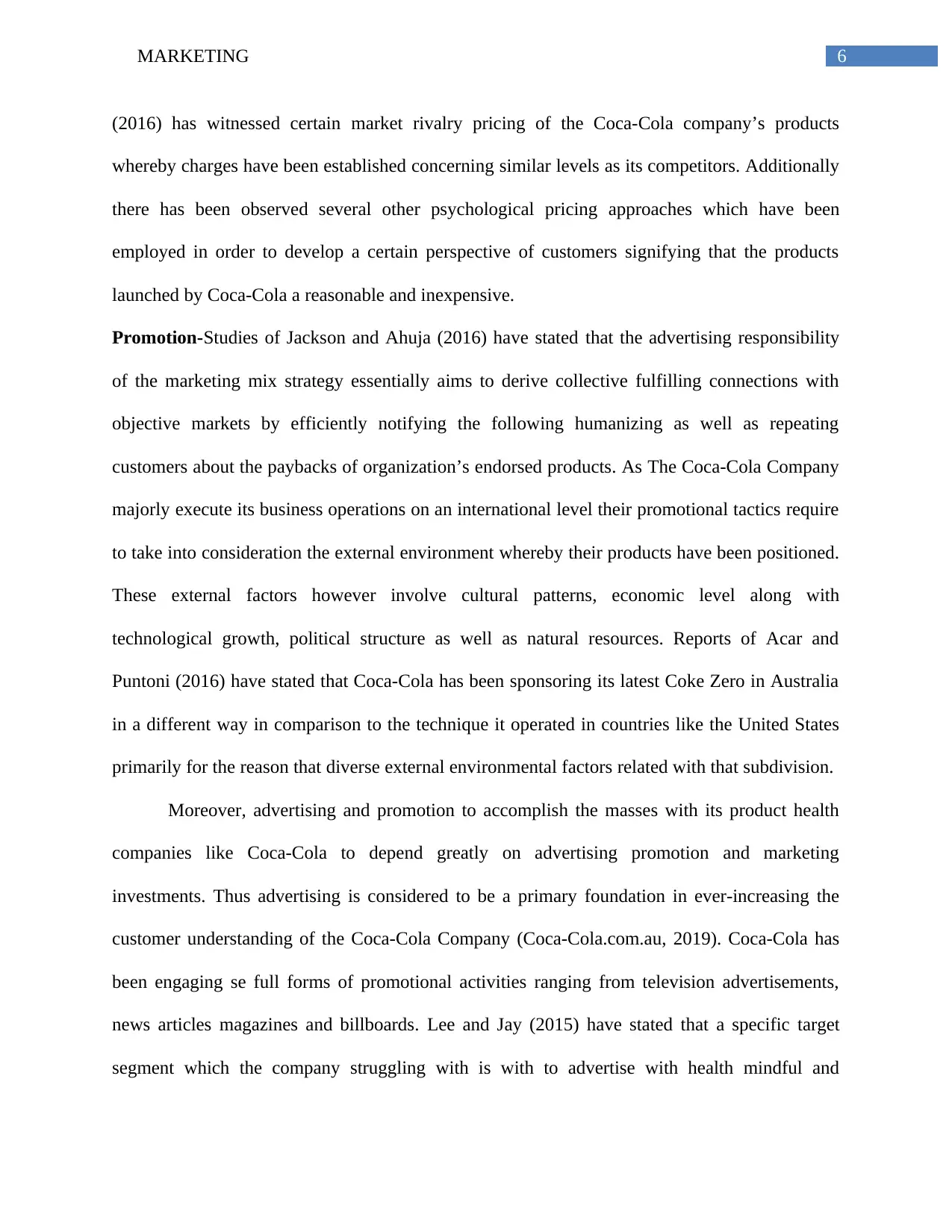
6MARKETING
(2016) has witnessed certain market rivalry pricing of the Coca-Cola company’s products
whereby charges have been established concerning similar levels as its competitors. Additionally
there has been observed several other psychological pricing approaches which have been
employed in order to develop a certain perspective of customers signifying that the products
launched by Coca-Cola a reasonable and inexpensive.
Promotion-Studies of Jackson and Ahuja (2016) have stated that the advertising responsibility
of the marketing mix strategy essentially aims to derive collective fulfilling connections with
objective markets by efficiently notifying the following humanizing as well as repeating
customers about the paybacks of organization’s endorsed products. As The Coca-Cola Company
majorly execute its business operations on an international level their promotional tactics require
to take into consideration the external environment whereby their products have been positioned.
These external factors however involve cultural patterns, economic level along with
technological growth, political structure as well as natural resources. Reports of Acar and
Puntoni (2016) have stated that Coca-Cola has been sponsoring its latest Coke Zero in Australia
in a different way in comparison to the technique it operated in countries like the United States
primarily for the reason that diverse external environmental factors related with that subdivision.
Moreover, advertising and promotion to accomplish the masses with its product health
companies like Coca-Cola to depend greatly on advertising promotion and marketing
investments. Thus advertising is considered to be a primary foundation in ever-increasing the
customer understanding of the Coca-Cola Company (Coca-Cola.com.au, 2019). Coca-Cola has
been engaging se full forms of promotional activities ranging from television advertisements,
news articles magazines and billboards. Lee and Jay (2015) have stated that a specific target
segment which the company struggling with is with to advertise with health mindful and
(2016) has witnessed certain market rivalry pricing of the Coca-Cola company’s products
whereby charges have been established concerning similar levels as its competitors. Additionally
there has been observed several other psychological pricing approaches which have been
employed in order to develop a certain perspective of customers signifying that the products
launched by Coca-Cola a reasonable and inexpensive.
Promotion-Studies of Jackson and Ahuja (2016) have stated that the advertising responsibility
of the marketing mix strategy essentially aims to derive collective fulfilling connections with
objective markets by efficiently notifying the following humanizing as well as repeating
customers about the paybacks of organization’s endorsed products. As The Coca-Cola Company
majorly execute its business operations on an international level their promotional tactics require
to take into consideration the external environment whereby their products have been positioned.
These external factors however involve cultural patterns, economic level along with
technological growth, political structure as well as natural resources. Reports of Acar and
Puntoni (2016) have stated that Coca-Cola has been sponsoring its latest Coke Zero in Australia
in a different way in comparison to the technique it operated in countries like the United States
primarily for the reason that diverse external environmental factors related with that subdivision.
Moreover, advertising and promotion to accomplish the masses with its product health
companies like Coca-Cola to depend greatly on advertising promotion and marketing
investments. Thus advertising is considered to be a primary foundation in ever-increasing the
customer understanding of the Coca-Cola Company (Coca-Cola.com.au, 2019). Coca-Cola has
been engaging se full forms of promotional activities ranging from television advertisements,
news articles magazines and billboards. Lee and Jay (2015) have stated that a specific target
segment which the company struggling with is with to advertise with health mindful and
Paraphrase This Document
Need a fresh take? Get an instant paraphrase of this document with our AI Paraphraser
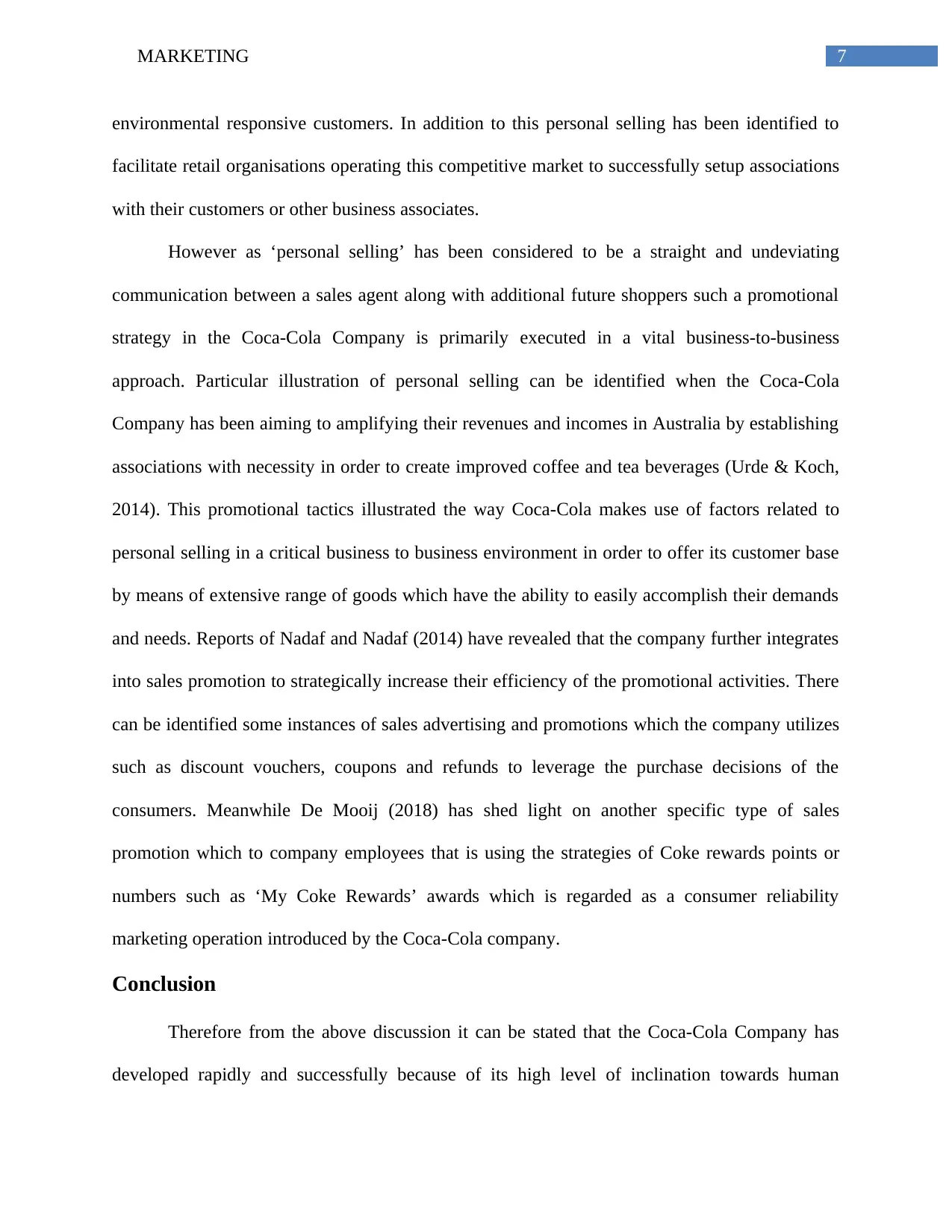
7MARKETING
environmental responsive customers. In addition to this personal selling has been identified to
facilitate retail organisations operating this competitive market to successfully setup associations
with their customers or other business associates.
However as ‘personal selling’ has been considered to be a straight and undeviating
communication between a sales agent along with additional future shoppers such a promotional
strategy in the Coca-Cola Company is primarily executed in a vital business-to-business
approach. Particular illustration of personal selling can be identified when the Coca-Cola
Company has been aiming to amplifying their revenues and incomes in Australia by establishing
associations with necessity in order to create improved coffee and tea beverages (Urde & Koch,
2014). This promotional tactics illustrated the way Coca-Cola makes use of factors related to
personal selling in a critical business to business environment in order to offer its customer base
by means of extensive range of goods which have the ability to easily accomplish their demands
and needs. Reports of Nadaf and Nadaf (2014) have revealed that the company further integrates
into sales promotion to strategically increase their efficiency of the promotional activities. There
can be identified some instances of sales advertising and promotions which the company utilizes
such as discount vouchers, coupons and refunds to leverage the purchase decisions of the
consumers. Meanwhile De Mooij (2018) has shed light on another specific type of sales
promotion which to company employees that is using the strategies of Coke rewards points or
numbers such as ‘My Coke Rewards’ awards which is regarded as a consumer reliability
marketing operation introduced by the Coca-Cola company.
Conclusion
Therefore from the above discussion it can be stated that the Coca-Cola Company has
developed rapidly and successfully because of its high level of inclination towards human
environmental responsive customers. In addition to this personal selling has been identified to
facilitate retail organisations operating this competitive market to successfully setup associations
with their customers or other business associates.
However as ‘personal selling’ has been considered to be a straight and undeviating
communication between a sales agent along with additional future shoppers such a promotional
strategy in the Coca-Cola Company is primarily executed in a vital business-to-business
approach. Particular illustration of personal selling can be identified when the Coca-Cola
Company has been aiming to amplifying their revenues and incomes in Australia by establishing
associations with necessity in order to create improved coffee and tea beverages (Urde & Koch,
2014). This promotional tactics illustrated the way Coca-Cola makes use of factors related to
personal selling in a critical business to business environment in order to offer its customer base
by means of extensive range of goods which have the ability to easily accomplish their demands
and needs. Reports of Nadaf and Nadaf (2014) have revealed that the company further integrates
into sales promotion to strategically increase their efficiency of the promotional activities. There
can be identified some instances of sales advertising and promotions which the company utilizes
such as discount vouchers, coupons and refunds to leverage the purchase decisions of the
consumers. Meanwhile De Mooij (2018) has shed light on another specific type of sales
promotion which to company employees that is using the strategies of Coke rewards points or
numbers such as ‘My Coke Rewards’ awards which is regarded as a consumer reliability
marketing operation introduced by the Coca-Cola company.
Conclusion
Therefore from the above discussion it can be stated that the Coca-Cola Company has
developed rapidly and successfully because of its high level of inclination towards human
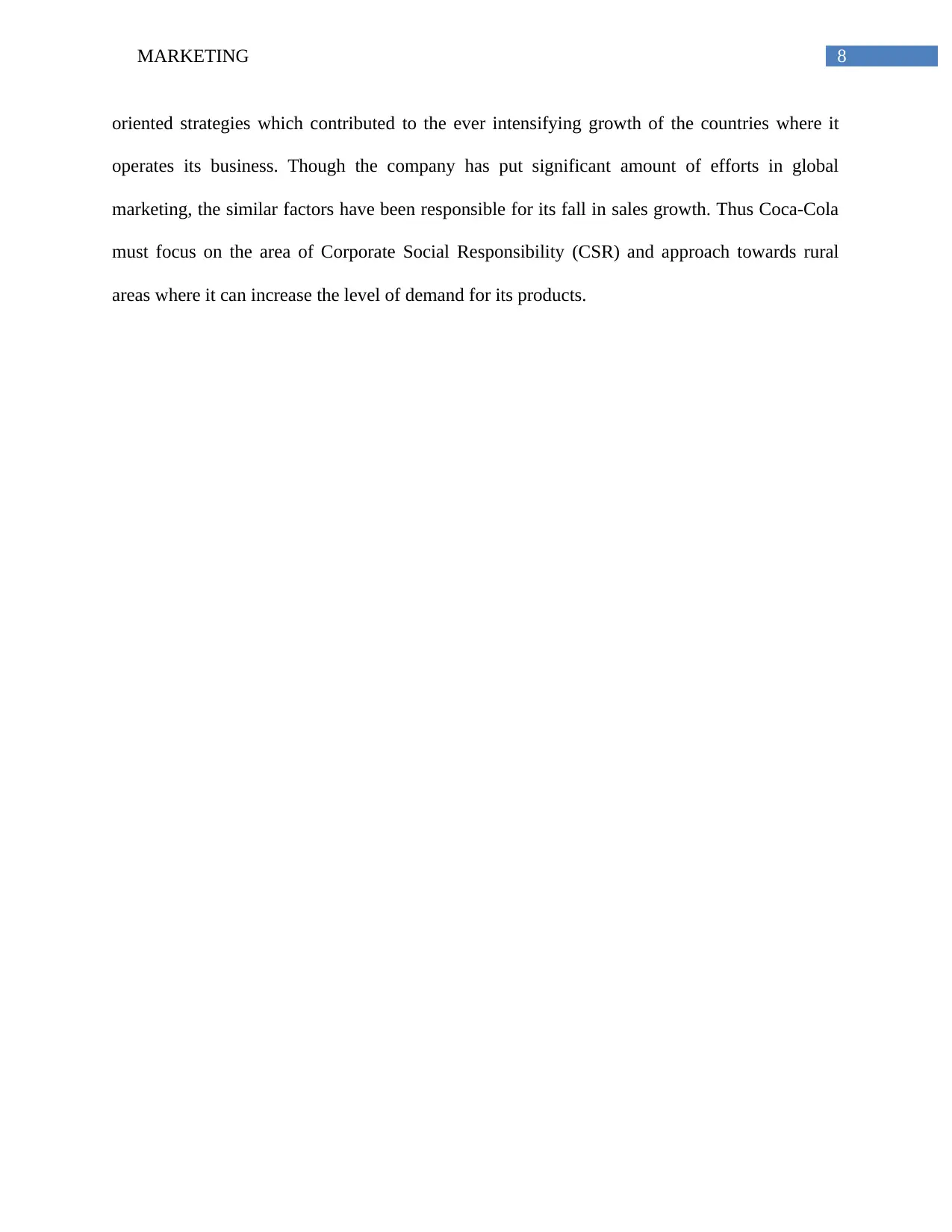
8MARKETING
oriented strategies which contributed to the ever intensifying growth of the countries where it
operates its business. Though the company has put significant amount of efforts in global
marketing, the similar factors have been responsible for its fall in sales growth. Thus Coca-Cola
must focus on the area of Corporate Social Responsibility (CSR) and approach towards rural
areas where it can increase the level of demand for its products.
oriented strategies which contributed to the ever intensifying growth of the countries where it
operates its business. Though the company has put significant amount of efforts in global
marketing, the similar factors have been responsible for its fall in sales growth. Thus Coca-Cola
must focus on the area of Corporate Social Responsibility (CSR) and approach towards rural
areas where it can increase the level of demand for its products.
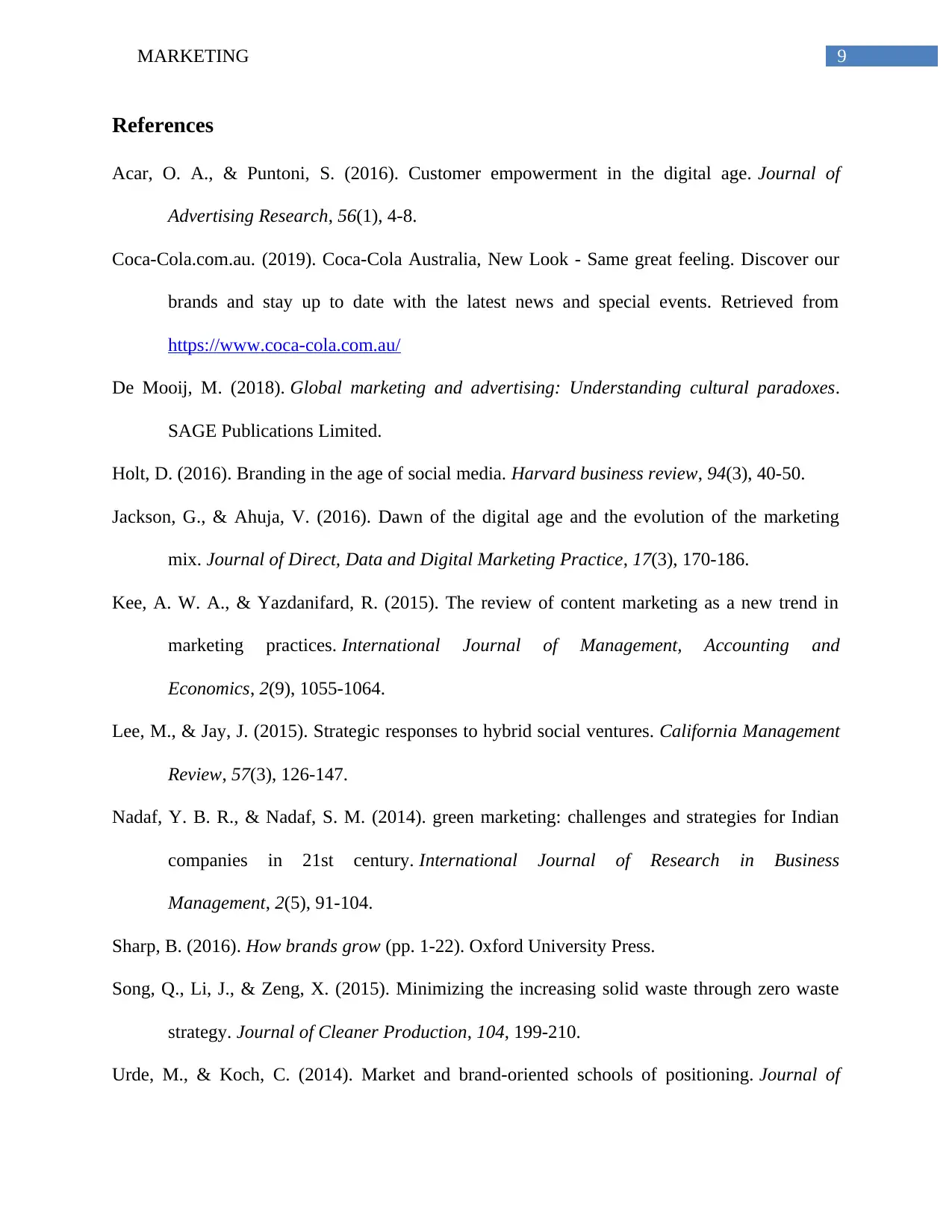
9MARKETING
References
Acar, O. A., & Puntoni, S. (2016). Customer empowerment in the digital age. Journal of
Advertising Research, 56(1), 4-8.
Coca-Cola.com.au. (2019). Coca-Cola Australia, New Look - Same great feeling. Discover our
brands and stay up to date with the latest news and special events. Retrieved from
https://www.coca-cola.com.au/
De Mooij, M. (2018). Global marketing and advertising: Understanding cultural paradoxes.
SAGE Publications Limited.
Holt, D. (2016). Branding in the age of social media. Harvard business review, 94(3), 40-50.
Jackson, G., & Ahuja, V. (2016). Dawn of the digital age and the evolution of the marketing
mix. Journal of Direct, Data and Digital Marketing Practice, 17(3), 170-186.
Kee, A. W. A., & Yazdanifard, R. (2015). The review of content marketing as a new trend in
marketing practices. International Journal of Management, Accounting and
Economics, 2(9), 1055-1064.
Lee, M., & Jay, J. (2015). Strategic responses to hybrid social ventures. California Management
Review, 57(3), 126-147.
Nadaf, Y. B. R., & Nadaf, S. M. (2014). green marketing: challenges and strategies for Indian
companies in 21st century. International Journal of Research in Business
Management, 2(5), 91-104.
Sharp, B. (2016). How brands grow (pp. 1-22). Oxford University Press.
Song, Q., Li, J., & Zeng, X. (2015). Minimizing the increasing solid waste through zero waste
strategy. Journal of Cleaner Production, 104, 199-210.
Urde, M., & Koch, C. (2014). Market and brand-oriented schools of positioning. Journal of
References
Acar, O. A., & Puntoni, S. (2016). Customer empowerment in the digital age. Journal of
Advertising Research, 56(1), 4-8.
Coca-Cola.com.au. (2019). Coca-Cola Australia, New Look - Same great feeling. Discover our
brands and stay up to date with the latest news and special events. Retrieved from
https://www.coca-cola.com.au/
De Mooij, M. (2018). Global marketing and advertising: Understanding cultural paradoxes.
SAGE Publications Limited.
Holt, D. (2016). Branding in the age of social media. Harvard business review, 94(3), 40-50.
Jackson, G., & Ahuja, V. (2016). Dawn of the digital age and the evolution of the marketing
mix. Journal of Direct, Data and Digital Marketing Practice, 17(3), 170-186.
Kee, A. W. A., & Yazdanifard, R. (2015). The review of content marketing as a new trend in
marketing practices. International Journal of Management, Accounting and
Economics, 2(9), 1055-1064.
Lee, M., & Jay, J. (2015). Strategic responses to hybrid social ventures. California Management
Review, 57(3), 126-147.
Nadaf, Y. B. R., & Nadaf, S. M. (2014). green marketing: challenges and strategies for Indian
companies in 21st century. International Journal of Research in Business
Management, 2(5), 91-104.
Sharp, B. (2016). How brands grow (pp. 1-22). Oxford University Press.
Song, Q., Li, J., & Zeng, X. (2015). Minimizing the increasing solid waste through zero waste
strategy. Journal of Cleaner Production, 104, 199-210.
Urde, M., & Koch, C. (2014). Market and brand-oriented schools of positioning. Journal of
Secure Best Marks with AI Grader
Need help grading? Try our AI Grader for instant feedback on your assignments.
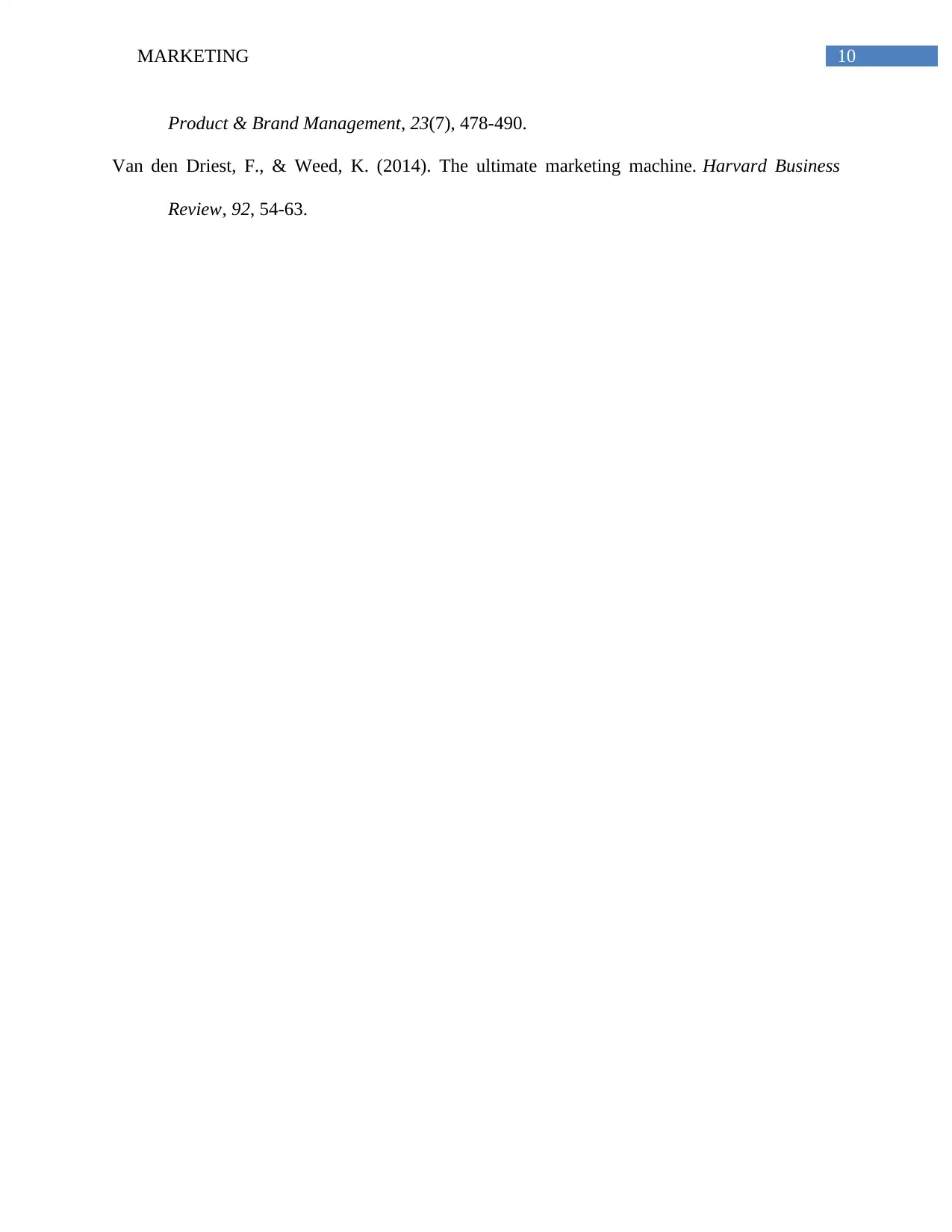
10MARKETING
Product & Brand Management, 23(7), 478-490.
Van den Driest, F., & Weed, K. (2014). The ultimate marketing machine. Harvard Business
Review, 92, 54-63.
Product & Brand Management, 23(7), 478-490.
Van den Driest, F., & Weed, K. (2014). The ultimate marketing machine. Harvard Business
Review, 92, 54-63.
1 out of 11
Related Documents
Your All-in-One AI-Powered Toolkit for Academic Success.
+13062052269
info@desklib.com
Available 24*7 on WhatsApp / Email
![[object Object]](/_next/static/media/star-bottom.7253800d.svg)
Unlock your academic potential
© 2024 | Zucol Services PVT LTD | All rights reserved.





